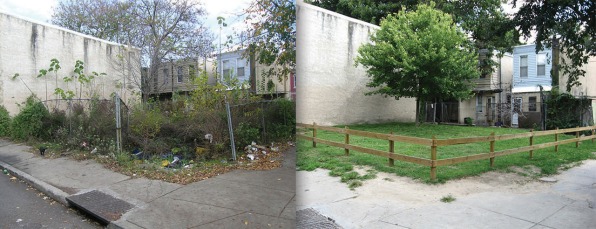A groundbreaking new study shows that access to “greened” vacant lots reduced feelings of worthlessness and depression, especially in low-resource neighborhoods.
What’s in a fence? More than you’d think. In neighborhoods where as little as about $1,000 was spent transforming a vacant lot with some grass, a few trees, and a short wooden fence, people felt less depressed and less worthless.
“The beauty of the intervention is that it’s pretty simple,” says Dr. Eugenia C. South, one of the authors on a new study that tracked hundreds of vacant lots across Philadelphia. “Which is good for replication in other cities and being able to scale it up. Also, the cost is relatively inexpensive compared to other types of interventions you might do for health.”
The study, published in JAMA Network Open by a group of five doctors at the University of Pennsylvania including South, is the first to observe a cause and effect between access to “greened” vacant lots and improved mental health through a randomized controlled trial. Their research paints a vivid picture of how our neighborhoods impact our well-being and provides new evidence for why cities should be investing in low-cost but high-impact design interventions like lot greening in blighted neighborhoods.

From our partners:
What’s so fascinating about their research–beyond observing a direct link between mental health and green space–is that the “greening” itself was extremely limited.
The Horticultural Society spends between $1,000 and $3,000 on each project and greens about 400 lots every year. The group clears away trash, razes the ground, plants some grass and maybe a couple trees, and then adds a low wooden fence, which seems to visually symbolize that the space as cared-for and invested-in. “Fences were originally installed to discourage short dumping of construction debris, a common occurrence on many blighted lots,” the group explains. “The wooden post-and-rail fence is not intended to keep people out of the lots, but rather to define the perimeter and signal that the lot is a well-maintained property and part of a citywide program. The fence has become the ‘brand’ of the Philadelphia LandCare program.”
The group doesn’t install benches, paths, or swingsets, nor did the study didn’t look at whether people nearby used the green lots–just that they were exposed to them. That suggests that “merely being visually exposed to nature may evoke critical biological responses,” write Michael Jerrett and Matilda van den Bosch in an essay about the study. “Because greening existing landscapes is usually less expensive than, say, constructing new urban parks, the finding may imply a cost-efficient way of improving mental health, especially in deprived neighborhoods.”
That’s not to say people wouldn’t benefit from green lots with more amenities–in fact, South wants to study those in the future–but that cities can create similar programs with positive effects at a very low baseline cost.
Other cities are working to create policy programs that leverage vacant land. Chicago, for instance, has a program called Large Lots that lets residents buy vacant lots near their homes for $1. The program has seen more than 1,200 lots sold since 2014, many to residents who say they were already caring for the vacant lots before they bought them and many of which serve as ad hoc parklands, gardens, or event spaces. Researchers from the University of Illinois are studying the impact the program is having on Chicago communities.
Over the past decade, a rash of high-profile, high-budget park projects, like the High Line in New York, have woken up many cities to the benefits that green spaces can bring to neighborhoods. But research like Penn’s is a reminder that parks can be inexpensive, ubiquitous, and simple. Even at the scale of a vacant lot, simply seeing greenery can make us feel better.
This feature is written by Kelsey Campbell-Dollaghan & originally appeared in Fast Company.















